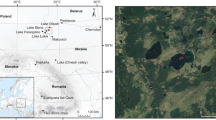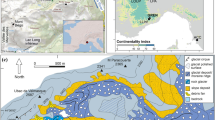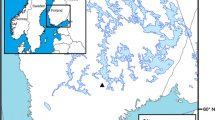Abstract
In order to investigate the relationship between vegetation change and fire history in the Siberian boreal forest, fossil pollen and charcoal from two lakes in central Yakutia, eastern Siberia, were analyzed. The vegetation change inferred from the pollen analysis was similar to that found in previous research in the region. Open larch forest covered this region during the late Glacial and early Holocene periods. Later, during the mid-Holocene, Scots pine expanded its range. The low levels of charcoal in the lake deposits represent surface forest fires, suggesting that the present-day surface fire regime has been taking place since at least 6,500 calibrated years before the present (cal yr BP) and that stand-replacing fire has not occurred during the Holocene. Larch and Scots pine forests, which are characterized by surface fire regimes, have been predominant since the early Holocene.



Similar content being viewed by others
References
Andreev AA, Klimanov VA (1989) Vegetation and climate history of central Yakutia during the holocene and late pleistocene. In: Ivanov BF, Palymsky BF (eds) Formation of deposits and placers in the northeast USSR. Northeast Interdisciplinary Research Institute, Far East Branch, Russian Academy of Sciences, Magadan, pp 28–51
Andreev AA, Tarasov PE (2007) Pollen records, postglacial: northern Asia. In: Elias S (ed) Encyclopedia of quaternary science, vol 4. Elsevier, Amsterdam, pp 2721–2729
Andreev AA, Klimanov VA, Sulerzhitsky LD, Khotinsky NA (1989) Chronology of landscape-climate changes in central Yakutia during the holocene. In: Khotinsky NA (ed) Paleoklimaty pozdnego pleistotsena i golotsena. Nauka, Moscow, pp 116–121
Andreev AA, Klimanov VA, Sulerzhitsky LD (1997) Younger dryas pollen records from central and southern Yakutia. Quat Int 41:111–117
Andreev AA, Klimanov VA, Sulerzhitsky LD (2002) Vegetation and climate history of central Yakutia during the holocene and late pleistocene. Botanicheskiy Zhurnal 87:86–98
Bengtsson L, Enell M (1986) Chemical analysis. In: Berglund BE (ed) Handbook of Holocene palaeoecology and palaeohydrology. Wiley, Chichester, pp 423–451
Clark JS, Hussey TC (1996) Estimating the mass flux of charcoal from sedimentary records: effects of particle size, morphology, and orientation. Holocene 6:129–144
Clark JS, Lynch J, Stocks BJ, Goldammer JG (1998) Relationships between charcoal particles in air and sediments in west-central Siberia. Holocene 8:19–29
Dean WEJ (1974) Determination of carbonate and organic matter in calcareous sediments and sedimentary rocks by loss on ignition: comparison with other methods. J Sediment Petrol 24:242–248
Deevey ESJ, Gross MS, Hutchinson GE, Kraybill HL (1954) The natural C14 contents of materials from hard-water lakes. Proc Natl Acad Sci 40:285–288
Faegri F, Iversen J (1989) Textbook of pollen analysis, 4th edn. Wiley, Chichester
Fischlin A, Midgley GF, Price JT, Leemans R, Gopal B, Turley C, Rounsevell MDA, Dube OP, Tarazona J, Velichko AA (2007) Ecosystems, their properties, goods, and services. In: Parry ML, Canziani OF, Palutikof JP, van der Linden PJ, Hanson CE (eds) Climate change 2007: impacts, adaptation and vulnerability; contribution of working group II to the fourth assessment report of the intergovernmental panel on climate change. Cambridge University Press, Cambridge, pp 211–272
Ivanov MS (1984) Cryogenic composition of quaternary deposition of Lena-Aldan depression. Nauka, Novosibirsk
Ivanova GA (1996) The extreme fire season in the central taiga forests of Yakutia. In: Goldammer JG, Furyaev VV (eds) Fire in ecosystems of boreal Eurasia. Kluwer Academic Publishers, Dordrecht, pp 260–270
Katamura F, Fukuda M, Bosikov NP, Desyatkin RV, Nakamura T, Moriizumi J (2006) Thermokarst formation and vegetation dynamics inferred from a palynological study in central Yakutia, eastern Siberia, Russia. Arct Antarct Alp Res 38:561–570
Katamura F, Fukuda M, Bosikov NP, Desyatkin RV (in press) Charcoal records from thermokarst deposits in central Yakutia, eastern Siberia: implications for forest fire history and thermokarst development. Quat Res
Lynch JA, Clark JS, Bigelow NH, Edwards ME, Finney BP (2002) Geographic and temporal variations in fire history in boreal ecosystems of Alaska. J Geophys Res 108:8152
Lynch JA, Clark JS, Stocks BJ (2004) Charcoal production, dispersal, and deposition from the fort providence experimental fire: interpreting fire regimes from charcoal records in boreal forests. Can J For Res 34:1642–1656
MacDonald GM, Beukens RP, Kieser WE, Vitt DH (1987) Comparative radiocarbon dating of terrestrial plant macrofossils and aquatic moss from the ‘‘ice-free corridor’’ of western Canada. Geology 15:837–840
MacDonald GM, Larsen CPS, Szeicz JM, Moser KA (1991) The reconstruction of boreal forest fire history from lake sediments: a comparison of charcoal, pollen, sedimentological, and geochemical indices. Quat Sci Rev 10:53–71
Moore PD, Webb JA, Collinson ME (1991) Pollen analysis. Blackwell Scientific, Oxford
Mouillot F, Field CB (2005) Fire history and the global carbon budget: a 1 degrees × 1 degrees fire history reconstruction for the 20th century. Global Change Biol 11:398–420
National Astronomical Observatory of Japan (2001) Chronological scientific tables. Maruzen, Tokyo
Ogden JG (1986) An alternative to exotic spore or pollen addition in quantitative microfossil studies. Can J Earth Sci 23:102–106
Pisaric MFJ, MacDonald GM, Velichko AA, Cwynar LC (2001) The Lateglacial and Postglacial vegetation history of the northwestern limits of Beringia, based on pollen, stomate and tree stump evidence. Quat Sci Rev 20:235–245
Popp S, Diekmann B, Meyer H, Siegert C, Syromyatnikov I, Hubberten HW (2006) Palaeoclimate signals as inferred from stable-isotope composition of ground ice in the Verkhoyansk foreland, central Yakutia. Permafr Periglac Proc 17:119–132
Reimer PJ, Baillie MGL, Bard E, Bayliss A, Beck JW, Bertrand CJH, Blackwell PG, Buck CE, Burr GS, Cutler KB et al (2004) IntCal04 Terrestrial radiocarbon age calibration, 0–26 cal kyr BP. Radiocarbon 46:1029–1058
Sherbakov IP (1979) Forest fires in Yakutia and their influence on the nature of forests. Nauka, Novosibirsk
Shugart HH, Smith TM, Post WM (1992) The potential for application of individual-based simulation-models for assessing the effects of global change. Annu Rev Ecol Syst 23:15–38
Soloviev PA (1973) Thermokarst phenomena and landforms due to frost heaving in central Yakutia. Peryglacialny Biuletyn 23:135–155
Stockmarr JA (1971) Tabletes with spores used in absolute pollen analysis. Pollen Spores 13:615–621
Stuiver M, Reimer PJ (1993) Extended C-14 data-base and revised calib 3.0 C-14 age calibration program. Radiocarbon 35:215–230
Takahashi K (2006) Future perspective of forest management in a Siberian permafrost area. In: Hatano R, Guggenberger G (eds) Symptoms of environmental change in Siberian permafrost region. Hokkaido University Press, Sapporo, pp 163–170
Tsvetkov PA (2004) Pyrophytic properties of the larch Larix gmelinii in terms of life strategies. Russ J Ecol 35:224–229
Velichko AA, Andreev AA, Klimanov VA (1997) Climate and vegetation dynamics in the tundra and forest zone during the late glacial and holocene. Quat Int 41:71–96
Whitlock C, Larsen C (2001) Charcoal as a fire proxy. In: Smol JP, Birks HJB, Last WM (eds) Tracking environmental change using lake sediments, terrestrial, algal, and siliceous indicators, vol 3. Kluwer Academic Publishers, Dortrecht, pp 75–97
Wirth C, Shulze E-D, Shulze W, von Stüntzer-Karbe D, Ziegler W, Miljukova IM, Sogatchev A, Varlagin AB, Panvyorov M, Grigoriev S et al (1999) Above-ground biomass and structure of pristine Siberian Scots pine forest as controlled by competition and fire. Oecologia 121:66–80
Zimov SA, Schuur EAG, Chapin FS (2006) Permafrost and the global carbon budget. Science 312:1612–1613
Acknowledgments
This research was financed by a Sasakawa Scientific Research Grant of The Japan Science Society, and a Research Fellowship from the Japan Society for the Promotion of Science for Young Scientists. We thank A. Fedorov for supporting the fieldwork, and H. Takahara for providing helpful comments regarding the charcoal measurements. We also thank R. Hatano and F. Takakai for helping with LOI analysis, and L. Lopez and two anonymous reviewers for thoughtful comments on this manuscript.
Author information
Authors and Affiliations
Corresponding author
About this article
Cite this article
Katamura, F., Fukuda, M., Bosikov, N.P. et al. Forest fires and vegetation during the Holocene in central Yakutia, eastern Siberia. J For Res 14, 30–36 (2009). https://doi.org/10.1007/s10310-008-0099-z
Received:
Accepted:
Published:
Issue Date:
DOI: https://doi.org/10.1007/s10310-008-0099-z




